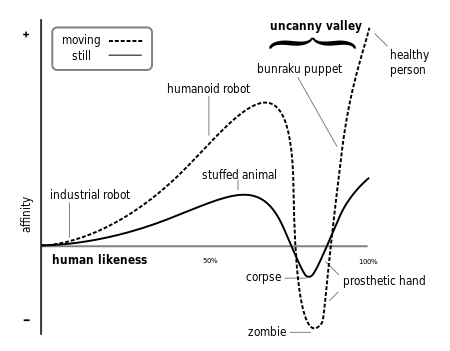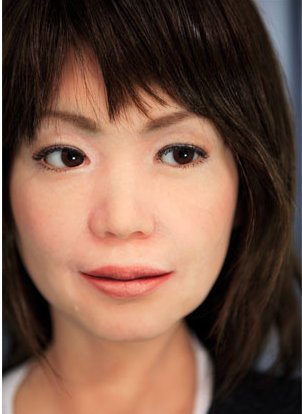
Why does this happen? The latest research has revealed that our brains put objects into two categories: human and non-human. When we see a non-human with human characteristics, like Wall-E or a cartoon character, we can see some of ourselves in something that clearly isn't us and it is appealing. But, once enough human characteristics have been added our brain starts to categorize the object as human changing the way we view it. As humans, we see and interact with other humans every day, all day long. We've become incredibly good at distinguishing what is and isn't human, and it's second nature. However, when we see something that almost looks human with just a few things off (slight plastic texture to the skin, awkward motions, etc...) it is disturbing because it looks almost alien in it's realism. Objects that fall into the uncanny valley generally cause us a large amount of discomfort to be around.


This also happens in other mediums as well, particularly video games. Humans evolved to use tools: hammers, spears, swords, knives, etc... Our brain has an amazing ability to almost attach the tool to our bodies, mentally. For people who play video games a lot they will often tell you that they get lost in the game and it can feel real. Instead of thinking "move my thumb left to move the thumb stick left to move the avatar on the screen left" we simply think "move left" and our tool-adapted brain will do everything else. Motion controls are what fall into the uncanny valley here. Anyone who's ever played Wii Sports can tell you that they don't feel like they're actually playing the sport, they're just playing a motion game, and the game will never become so immersive that they lose themselves while they play. The reason for this is because our brain recognizes a classic style video game controller as a tool and adjusts its' expectations accordingly. Motion controls however, fall into the category of almost-real-but-not-quite-there, also known as the uncanny valley. Until motion controls become indistinguishable from the real action, they will never be as immersive as a classic style video game.
Now, you might be asking yourself, "how does this relate to movies?" Well, the uncanny valley is incredibly effective at making us uncomfortable, and if the filmmaker wants to make us uncomfortable it can be one of the easiest, and most subtle ways. The best example of this I can think of is the movie "House on Haunted Hill (1999)" where the villain, a ghost, looked completely normal, but his motions when he walked were exaggerated, but also incredibly precise; he moved almost like a robot or a wind-up toy, but not like a human should move.
In the words of Ned Parks, (a close friend and film student) "[the uncanny valley is] underutilized, and with the right minds could be just what modern horror needs to bring it back to the glory days when atmosphere outweighed gore."
No comments:
Post a Comment